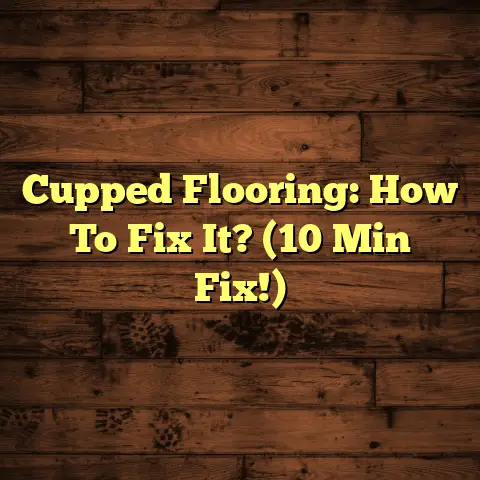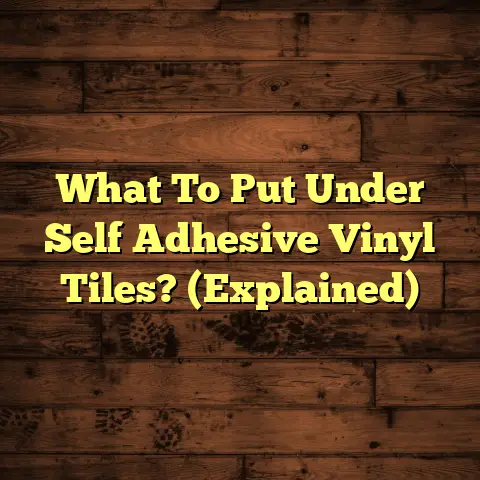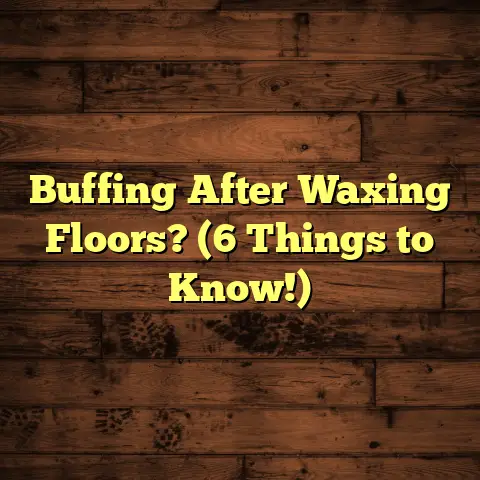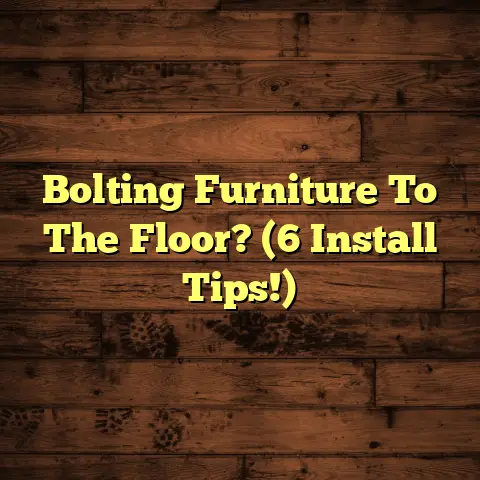Best Rug Pads For Wood Floors? (6 Top Choices!)
Think of your wood floors as an investment – a big one!
And just like any investment, you want to protect it.
That’s where rug pads come in.
They’re not just about keeping your rug from slipping; they’re about preserving the life and look of your gorgeous hardwood.
Choosing the right rug pad can be a game-changer.
It can enhance the aesthetics of your room, provide a cushiony feel underfoot, and, most importantly, shield your wood floors from scratches, dents, and wear.
But with so many options out there, how do you choose the best one?
Don’t worry; I’ve got you covered!
In this article, I’ll break down everything you need to know about rug pads for wood floors, from understanding your room-specific needs to my top 6 recommendations.
So, grab a cup of coffee, settle in, and let’s dive in!
Section 1: Understanding Room-Specific Needs
Before we jump into specific products, let’s talk about your home.
Each room has unique needs, and the best rug pad for your living room might not be the best choice for your kitchen.
Think about it: a cozy bedroom rug pad is different from a high-traffic hallway rug pad, right?
Let’s break it down by room:
Living Room
The living room is often a high-traffic area, a place where comfort, style, and protection need to work together.
Comfort and Cushioning: You want a rug pad that feels good underfoot.
A thicker felt pad or a combination pad with felt and rubber can provide that extra layer of comfort.Grip is Key: Preventing slips and falls is crucial, especially if you have kids or pets.
Look for a pad with a good grip to keep your rug in place.Style Considerations: The rug pad shouldn’t interfere with the look of your rug.
Choose a pad that’s slightly smaller than your rug to avoid it peeking out.
Bedroom
The bedroom is your sanctuary. Softness, warmth, and sound dampening are the priorities here.
Softness Underfoot: Imagine stepping out of bed onto a plush rug.
A thick felt or memory foam rug pad can make that dream a reality.Sound Dampening: Rug pads can absorb sound, making your bedroom quieter and more peaceful.
This is especially important if you live in an apartment or have noisy neighbors.
According to the National Wood Flooring Association (NWFA), adding a rug pad can reduce noise transmission by up to 50%.-
Warmth: A rug pad can provide an extra layer of insulation, keeping your feet warm on chilly mornings.
Kitchen
The kitchen is a high-traffic area prone to spills and messes.
Durability and ease of cleaning are essential.
-
Spill Protection: Look for a rug pad that’s waterproof or water-resistant to protect your wood floors from spills.
Durability: The kitchen sees a lot of foot traffic.
Choose a rug pad that can withstand wear and tear.Easy Cleaning: Opt for a rug pad that’s easy to clean or replace.
A thin rubber pad might be a good option here.
Dining Room
The dining room needs stability and protection from scratches caused by furniture.
-
Stability: You want a rug pad that keeps your rug in place, even when chairs are being pulled in and out.
-
Scratch Protection: A rug pad can prevent scratches caused by furniture legs or dropped items.
Thin Profile: Avoid overly thick pads that can make chairs wobble.
A thinner, denser pad is usually best.
Home Office
A home office needs a non-slip surface that can handle rolling office chairs without damaging the wood floor.
-
Non-Slip: A non-slip rug pad is essential to prevent the rug from moving around, especially under a rolling office chair.
-
Chair Protection: Look for a pad that can protect your wood floors from scratches and dents caused by the chair’s wheels.
-
Low Profile: A thinner pad is usually better to avoid making the chair feel unstable.
Hallways and Entryways
Hallways and entryways are high-traffic areas where slips and falls are a concern.
-
High Traction: You need a rug pad with excellent traction to prevent slips, especially in areas where people tend to walk quickly.
-
Durability: These areas see a lot of wear and tear, so choose a durable rug pad that can withstand heavy foot traffic.
-
Low Profile: Avoid overly thick pads that can create a tripping hazard.
Section 2: Essential Features of Rug Pads
Now that we’ve covered room-specific needs, let’s dive into the essential features to consider when choosing a rug pad for your wood floors.
Material Types
The material of your rug pad is a crucial factor.
Here’s a breakdown of the most common types:
Natural Rubber:
-
Benefits: Natural rubber is eco-friendly, provides excellent grip, and is naturally non-slip.
-
Drawbacks: It can sometimes have a strong odor, and some types can stain certain finishes (though this is rare with modern rubber rug pads).
-
My Experience: I’ve used natural rubber pads in my own home and have found them to be incredibly effective at preventing rugs from slipping.
Just make sure to choose a high-quality one from a reputable brand.
-
-
Felt:
-
Benefits: Felt provides excellent cushioning, is soft underfoot, and can help dampen sound.
-
Drawbacks: It doesn’t offer as much grip as rubber, so it’s often combined with a rubber backing.
-
My Experience: I often recommend felt pads for bedrooms and living rooms where comfort is a priority.
-
Synthetic Options (Memory Foam, PVC, etc.):
-
Benefits: Synthetic options can be budget-friendly and offer various levels of cushioning and grip.
-
Drawbacks: Some synthetic materials can off-gas chemicals, so it’s essential to choose a low-VOC (volatile organic compound) option.
PVC can also damage certain wood floor finishes over time. -
My Experience: I generally advise clients to steer clear of PVC pads due to the potential for damage.
Memory foam can be a good option for cushioning, but make sure it’s combined with a non-slip backing.
-
Thickness and Density
Thickness and density affect both cushioning and stability.
-
Thickness:
-
Thicker pads provide more cushioning and can help protect your floors from heavy furniture.
-
Thinner pads are less likely to interfere with door clearance and can be a better choice for dining rooms or hallways.
-
-
Density:
-
Denser pads are more durable and provide better support.
-
Less dense pads may compress over time and lose their effectiveness.
-
My Recommendation: For most situations, I recommend a rug pad that’s between 1/4 and 1/2 inch thick.
-
Non-Slip Features
Non-slip technology is crucial for preventing accidents and protecting your floors.
-
Rubber Backing: Rubber backing is one of the most effective ways to keep a rug in place.
-
Textured Surfaces: Some rug pads have textured surfaces that grip both the rug and the floor.
-
Combination Materials: Many rug pads combine different materials, such as felt and rubber, to provide both cushioning and grip.
Breathability
Breathability is essential for preventing moisture buildup and wood floor damage.
-
Natural Materials: Natural materials like rubber and felt are generally more breathable than synthetic options.
-
Open Weave: Some rug pads have an open weave design that allows air to circulate.
-
My Advice: Avoid rug pads that are completely waterproof, as they can trap moisture and lead to mold or mildew growth.
Section 3: Top 6 Rug Pads for Wood Floors
Alright, let’s get to the good stuff!
Based on my experience and research, here are my top 6 rug pad recommendations for wood floors:
1. RUGPADUSA – Cloud Comfort Memory Foam Rug Pad
-
Description: A high-density memory foam pad that provides exceptional comfort and support.
-
Key Features:
- High-density memory foam for superior cushioning.
- Non-slip backing to keep the rug in place.
- Hypoallergenic and odor-free.
-
Pros:
- Excellent comfort and support.
- Effective non-slip grip.
- Safe for wood floors.
-
Cons:
- Can be more expensive than other options.
- May not be suitable for high-traffic areas.
-
Ideal Use Cases: Bedrooms, living rooms, or any area where comfort is a priority.
-
Price Range: \$30 – \$150 (depending on size)
2. Mohawk Home Dual Surface Rug Pad
-
Description: A versatile rug pad with a felt top for cushioning and a rubber bottom for grip.
-
Key Features:
- Felt top for comfort and sound dampening.
- Rubber bottom for non-slip performance.
- Protects wood floors from scratches and dents.
-
Pros:
- Combines comfort and grip.
- Durable and long-lasting.
- Suitable for various room types.
-
Cons:
- May not be as plush as a memory foam pad.
- Can be slightly more expensive than basic rubber pads.
-
Ideal Use Cases: Living rooms, dining rooms, or any area where you need both comfort and stability.
-
Price Range: \$20 – \$100 (depending on size)
3. Gorilla Grip Original Area Rug Gripper Pad
-
Description: A durable and effective non-slip rug pad made from recycled materials.
-
Key Features:
- Open grid design for breathability.
- Strong grip to prevent rugs from slipping.
- Made from recycled materials.
-
Pros:
- Excellent non-slip performance.
- Eco-friendly.
- Affordable.
-
Cons:
- Doesn’t provide much cushioning.
- May not be suitable for delicate rugs.
-
Ideal Use Cases: Hallways, entryways, or any area where slip resistance is a top priority.
-
Price Range: \$15 – \$75 (depending on size)
4. Cloud Memory Foam Rug Pad by Life Holding
-
Description: This rug pad is crafted from dense memory foam, offering exceptional comfort and support.
-
Key Features:
- High-density memory foam enhances cushioning and support.
- Non-slip backing ensures the rug stays in place.
- Hypoallergenic and free from odors, promoting a healthy environment.
-
Pros:
- Provides outstanding comfort and support underfoot.
- Effectively prevents the rug from slipping.
- Safe for use on wood floors, protecting them from damage.
-
Cons:
- Can be pricier compared to other rug pad options.
- May not be the best choice for high-traffic areas due to potential wear.
-
Ideal Use Cases: Perfect for bedrooms, living rooms, or any area where maximum comfort is desired.
-
Price Range: \$35 – \$160 (depending on size)
5. Durahold Plus Felt and Rubber Rug Pad
-
Description: A premium rug pad that combines the comfort of felt with the non-slip grip of rubber.
-
Key Features:
- Thick felt for cushioning and sound absorption.
- Natural rubber backing for superior grip.
- Needle-punched construction for added durability.
-
Pros:
- Excellent comfort and grip.
- Protects wood floors from scratches and dents.
- Long-lasting and durable.
-
Cons:
- One of the more expensive options.
- May not be suitable for very thin rugs.
-
Ideal Use Cases: Living rooms, dining rooms, or any area where you want the best of both worlds: comfort and stability.
-
Price Range: \$40 – \$200 (depending on size)
6. Amazon Basics Non-Slip Rug Pad
-
Description: A budget-friendly option that provides basic non-slip protection.
-
Key Features:
- PVC construction with a non-slip surface.
- Easy to trim to fit any rug size.
- Affordable.
-
Pros:
- Inexpensive.
- Provides basic non-slip protection.
- Easy to customize.
-
Cons:
- PVC can potentially damage wood floor finishes over time.
- Doesn’t provide much cushioning.
- May not be as durable as other options.
-
Ideal Use Cases: Low-traffic areas or for temporary use.
-
Price Range: \$10 – \$50 (depending on size)
Important Note: Prices can vary depending on the retailer and the size of the rug pad.
Always check the product specifications and reviews before making a purchase.
Section 4: Installation and Maintenance Tips
Okay, you’ve chosen your rug pad – now what?
Here are some tips for installing and maintaining your rug pad to ensure it protects your wood floors for years to come:
Installation Tips
-
Clean Your Floors: Before installing the rug pad, make sure your wood floors are clean and dry.
-
Trim to Size: If the rug pad is too large, trim it to be slightly smaller than your rug (about 1-2 inches on each side).
-
Position Correctly: Place the rug pad with the non-slip side facing down on the wood floor.
-
Smooth Out Wrinkles: Make sure the rug pad is flat and smooth before placing the rug on top.
Maintenance Tips
-
Vacuum Regularly: Vacuum both the rug and the rug pad regularly to remove dirt and debris.
-
Spot Clean Spills: Clean up spills immediately to prevent them from soaking into the rug pad and damaging your wood floors.
Check for Wear and Tear: Periodically check the rug pad for signs of wear and tear, such as tears or compression.
Replace it if necessary.-
Rotate Your Rug: Rotating your rug can help distribute wear and tear evenly and prolong the life of both the rug and the rug pad.
-
Professional Cleaning: Consider having your rug and rug pad professionally cleaned every 12-18 months to remove deep-seated dirt and stains.
Conclusion
Choosing the right rug pad for your wood floors is an investment in the beauty and longevity of your home.
By considering your room-specific needs, understanding the essential features of rug pads, and following my installation and maintenance tips, you can ensure that your wood floors stay protected and beautiful for years to come.
Remember, the best rug pad for you depends on your individual needs and preferences.
Take the time to research your options and choose a rug pad that’s right for you and your home.
Happy flooring!





